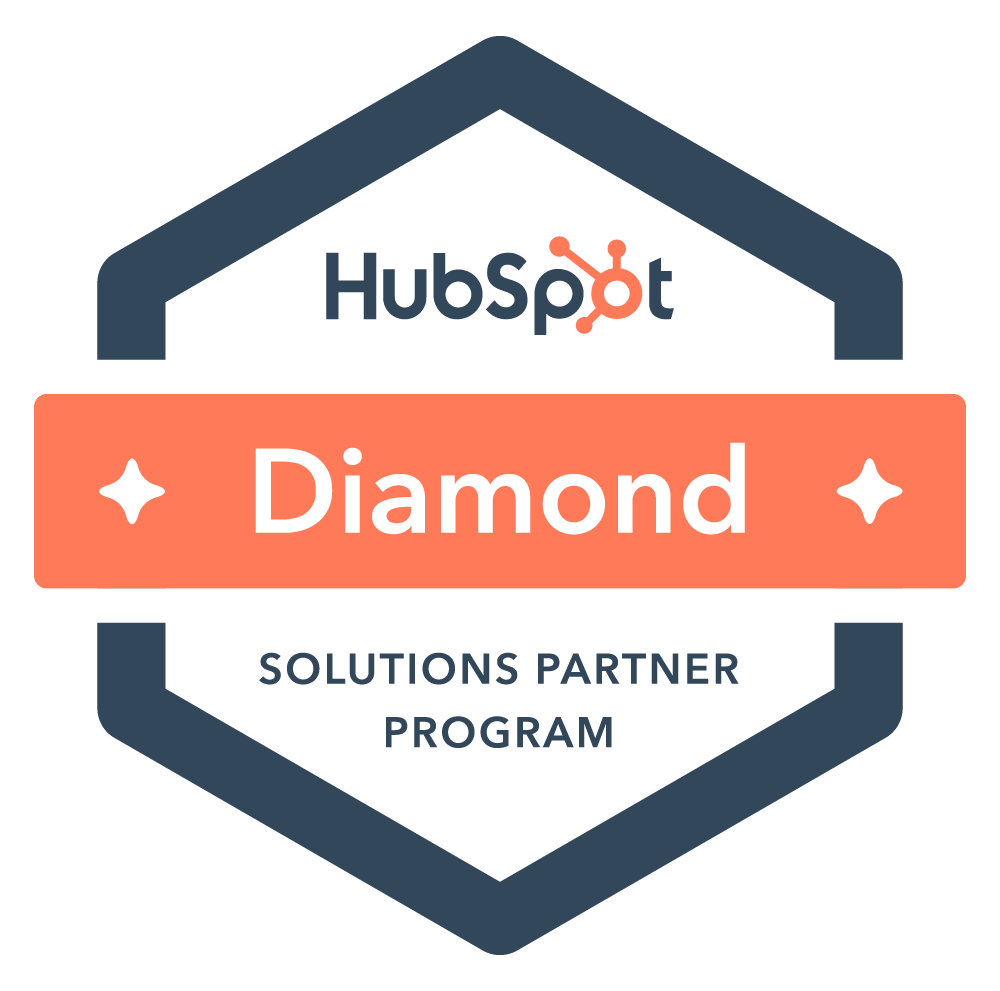-
Digital Marketing
We help you to use your digital potential. For a strong positioning, more visibility and more leads.
Sales Enablement
Targeted customer acquisition for more sales. Identify, target and close the right leads.
Get Growth ready
With the BEE.Transformance model, we bring continuous and profitable growth to your company. A new mindset for your team.
Industries
We transform your challenges into opportunities through the experience we have gained from projects in these industries.
-
HubSpot Services
As a HubSpot Diamond Partner, we help you implement your digital growth strategy with a focus on performance - by implementing and integrating new and existing systems as well as 3rd party apps.
HubSpot Thought Leader
As a HubSpot Diamond Partner with +50 certifications, host of the HubSpot User Group Zurich, HubSpot Trainer and HuSpot User Champions, you have access to in-depth HubSpot expertise.
HubSpot Solutions
The BEE.Theme offers you more creative freedom than any other theme on the market. Whether you're a beginner or a professional, a creative mind or a digital agency - with the BEE theme, you can easily unleash the maximum power for your pages in HubSpot CMS.
-
BEE.Blog
Knowledge around digital marketing, digital sales, technology, data intelligence and employees.
Knowledge Base
Pure knowledge: everything essential concentrated, compact, digitally prepared for you and ready to download.
What is inbound?
The most effective way to successfully combine digital marketing and digital sales.
-
BEE.Team
The BEE.Performers: many different characters - with one thing in common: the fascination for a digital world.
References
More than 100 large and small companies have already started with BEE: to more visibility, more performance, more growth.
Invest
Participate in the growth of BEE and become part of the BEE Growth Story by purchasing Digital Share Tokens.
We're hiring
Become a BEE.Performer! Are you ready for your own transformation?
The ultimate guide to marketing automation

What does the everyday life of a marketer actually look like?
Most of the time it's like this: checking and answering 3,000,000 emails, planning and checking five campaigns simultaneously, generating content, juggling numbers, coordinating events, PR briefings, meetings, meetings and even more meetings, fighting with IT, catching up with the sales team, and chasing service providers.
Do you recognise these activities? What if we told you that you could automate many of them? You would have much more time to be creative and to implement new ideas. This manual is designed to give you a comprehensive overview of marketing automation.
You don't have time to read the whole content now? Then simply download our guide in PDF format.
What is marketing automation?
Marketing automation is a software-based method to automate marketing processes. It enriches contact data with information based on user behaviour in order to start an individual communication.
Marketing automation is mostly used in connection with lead nurturing. But there are other ways of automating marketing processes. Here are a few applications that can be implemented in HubSpot, for example:
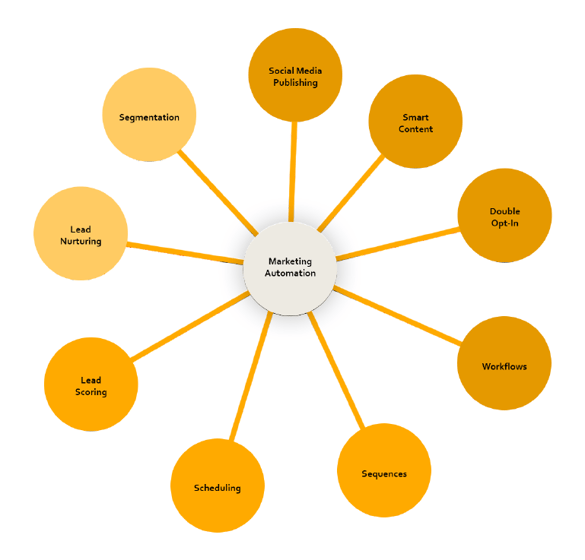
- Social media publishing: Posts can be pre-planned and published on different social media channels at a defined time.
- Smart content: Software such as HubSpot recognises returning visitors and adapts the content on a website for the visitor.
- Double-opt-in: After filling out a form for the first time, a double-opt-in email is automatically sent to the contact for confirmation.
- Workflows: An automated series of marketing actions is executed, depending on a starting condition.
- Sequences: A mixture of tasks for sales and follow-up communication with contacts.
- Appointment finding: Contacts can automatically book themselves into a free slot in the sales or marketing calendar.
- Lead scoring: Automated process that evaluates contacts according to the marketing and sales funnel phase they are in.
- Segmentation: Contacts are automatically sorted into different lists according to their selected properties, such as lifecycle stage, industry or country.
Marketing vs. Sales Automation
Basically, marketing automation is much more comprehensive than sales automation. While marketing automation can use comprehensive actions such as lead scoring, lead nurturing, social media, etc., sales automation is purely limited to sales. Nevertheless, various processes can be automated here.
For example, emails can be created as sequences that are played out to the qualified leads depending on the sales challenge, or tasks for follow-ups can be created automatically. It is always worth taking a look at these tools to make the work of your sales team easier.
 It’s important to remember that many automated marketing processes pay off in sales. Lead scoring gives sales the right information about whether leads are qualified or not. If the leads aren’t sufficiently warmed up, they are fed to sales via lead nurturing. This is why the collaboration between marketing and sales is so incredibly important.
It’s important to remember that many automated marketing processes pay off in sales. Lead scoring gives sales the right information about whether leads are qualified or not. If the leads aren’t sufficiently warmed up, they are fed to sales via lead nurturing. This is why the collaboration between marketing and sales is so incredibly important.
What is lead nurturing?
The Online Marketing Praxis defines lead nurturing as follows:
Lead Nurturing (eng. to nurture) comprises all lead management actions that a company takes in order to address interested parties with relevant information at the right time, according to the respective phase of the purchase decision in which the interested party is currently in.
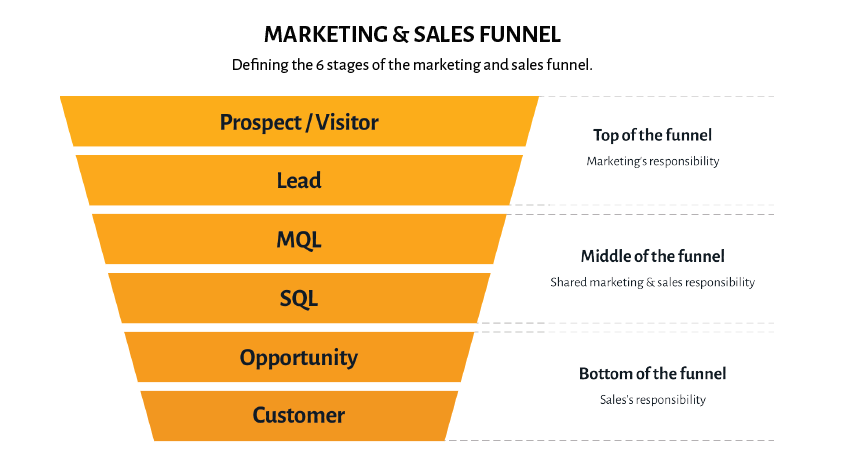 Leads are divided into different phases of the marketing and sales funnel (see figure). The goal is to turn a visitor into a customer. Various types of marketing automation can be used to achieve this. Depending on the phase of the customer journey, contacts are offered different relevant content, for example, by email. If the contact engages with the content, they slide one step further in the funnel.
Leads are divided into different phases of the marketing and sales funnel (see figure). The goal is to turn a visitor into a customer. Various types of marketing automation can be used to achieve this. Depending on the phase of the customer journey, contacts are offered different relevant content, for example, by email. If the contact engages with the content, they slide one step further in the funnel.
Lead nurturing is usually combined with email marketing. There are different types of marketing automation:
Information: General informative emails that show the value of the company's offerings.
Advertising: Advertising emails directed to segments with qualified leads.
Interaction: Emails with informative content (advice and information) closely related to the interests of the lead and the content that led to the initial conversion.
Qualification: Emails with demo versions or free trial offers when a lead has viewed product information in an email or on the website.
MQL to SQL: Personal and targeted emails from a sales representative.
Assistance: Follow-up emails with further information on a specific topic.
DID YOU KNOW?
Lead nurturing promotes a 20% increase in sales. (Demandgen)
Lead nurturing generates 50% more ready-to-buy leads at 33% less cost. (Forrester Research)
Targeted lead nurturing emails generate 18 times more revenue than impersonal mass emails. (Juniper Research)
Step by step to automation
Before choosing the right marketing automation tools for your business and creating a campaign, the following steps should be planned:
- Set clear goals: You can follow the SMART rule. The goals must be Specific, Measurable, Achievable, Realistic and Timed. Only then is it really possible to measure and improve a campaign as we’ll discuss in step 5.
- Select a persona: The key to inbound marketing is the buyer persona – a fictitious persona that represents your own typical customer. This concept makes it easier to better understand the needs, challenges, and actions of the ideal customer.
- Using old and new content: You don't always have to reinvent the wheel. Often. there is already good content that can be edited or revised. Therefore, content research is advisable before developing a campaign.
- Set a schedule: When will you publish each individual piece of content? When will you send a specific email in your lead nurture sequence to a contact? ? Is there a particular timeline that must be followed when reaching out to a contact? What delays are planned? Many questions that should be clarified in advance so that a campaign, and especially a workflow, can be set up.
- Measure and improve: A campaign is only as good as the numbers and the results you can draw from it – before and after the campaign. Use the numbers to become even better.
How does lead scoring work?
Lead scoring is pretty much what it sounds like: you assign scores to the leads in your pipeline to help your sales and marketing teams recognise the interest of the leads in your products or services.
HubSpot, for example, provides a special feature for this. With manual lead scoring, you can assign positive and negative attributes to your contacts to achieve a HubSpot score for them.
When setting up lead scoring, think about the actions a user can take on your site that are important to your business. It can be helpful to write down some of these actions and assign a score to them. This makes it easier for you to set a minimum score to qualify your leads.
Here is an example:
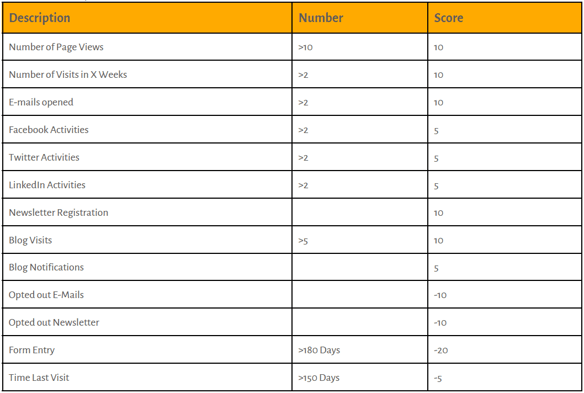 Pro Tip: Since workflows do not automatically determine scoring, scoring values for leads, MQLs, SQLs and customers should be defined and included in workflows.
Pro Tip: Since workflows do not automatically determine scoring, scoring values for leads, MQLs, SQLs and customers should be defined and included in workflows.
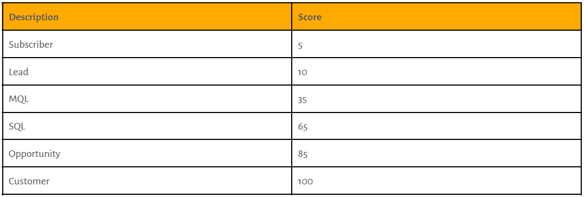
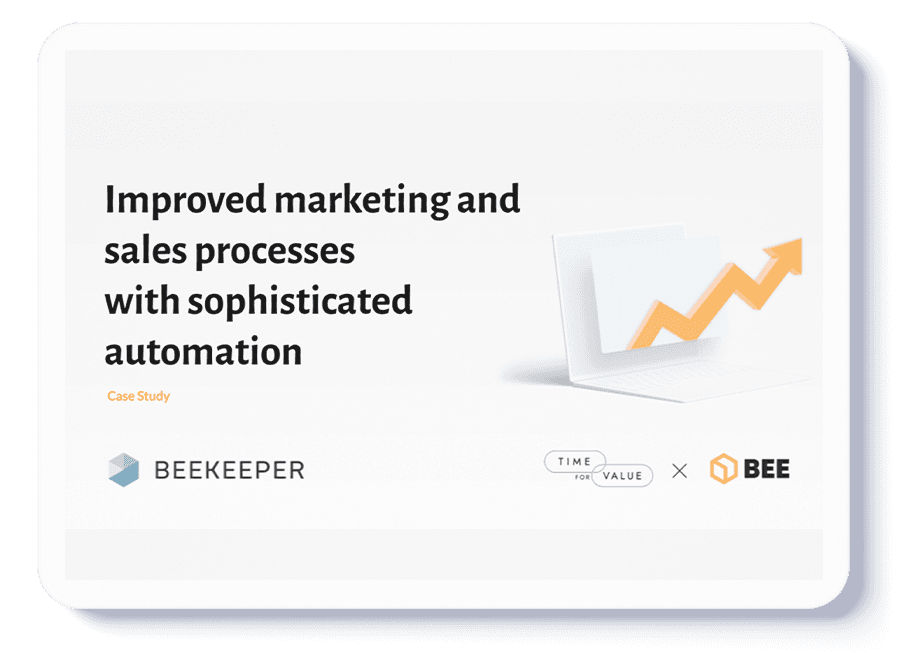
Case Study
We will show you how Beekeeper increased its MQL conversion rate by 66% through multidimensional lead scoring.
Advantages of marketing automation
Why should you implement marketing automation in your company? To answer this question, we’ve listed all of the advantages here.
Lead Qualification
The key to inbound marketing is the generation of inbound leads. But what comes next? Lead qualification, of course. And this is precisely where marketing automation can be a huge support for marketers.
Source: LeadMD “The 2016 Marketing Maturity Benchmark Report” (2016)
TIME SAVING
In addition to lead qualification, the focus is clearly on saving time. Many of the daily activities are simply taken over by the algorithm, and there is more time for more creative tasks.

Source: AdestraMarketer vs Machine (2015)
PRODUCTIVITY INCREASE
Marketing automation also helps to increase productivity. Leads are nurtured faster, new and more creative marketing activities are developed, and sales can access qualified leads faster and easier.

Source: Adestra “State of Marketing Automation Benchmarks for Success” (2017)
INCREASE OF THE ROI
If you consider all of the the above-mentioned advantages, you arrive at what is probably the most important thing in marketing: the increase in ROI.

Source: SharpSpring "State of marketing automation for agencies" (2017)
Marketing automation software at a glance
We at BEE Inbound use HubSpot as marketing automation software because it is the best choice for us. But that does not mean it is the right choice for your business. There are currently over 200 different marketing automation software products on the market.
Capterra has created a comprehensive overview that lists the main differences between the most popular vendors:
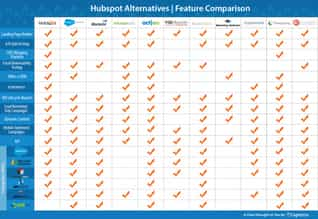
DID YOU KNOW?
G2 Crowd has declared HubSpot to be the leading marketing automation software in 2020.
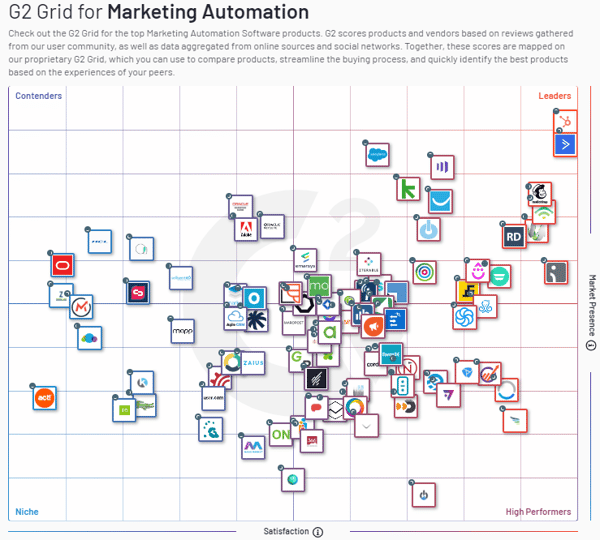
The best marketing automation software products are determined by customer satisfaction (based on user ratings) and scaling (based on market share, vendor size and social impact). They are ranked in four categories on the grid:
- Leading companies offer marketing automation products that are highly valued by G2 Crowd users and have significant scale, market share and global support and service resources.
- High performers offer products that are highly rated by their users but have not yet reached the market share and size of the vendors in the leader category.
- Competitors have significant market presence and resources, but their products have a below-average user experience or have not yet received a sufficient number of ratings to validate their products.
- Niche products do not have the market presence of the leaders. While they have received positive ratings for customer satisfaction, they have not yet received enough reviews to validate their success.
Summary
In summary, marketing automation should be an integral part of every company. Without it, you give away many benefits – namely, the leads that ultimately turn into business transactions.
Make more time for creativity and innovation by automating repetitive processes immediately and watch your ROI increase.
You want to share the guide with someone else? Then simply download our guide as a PDF file.
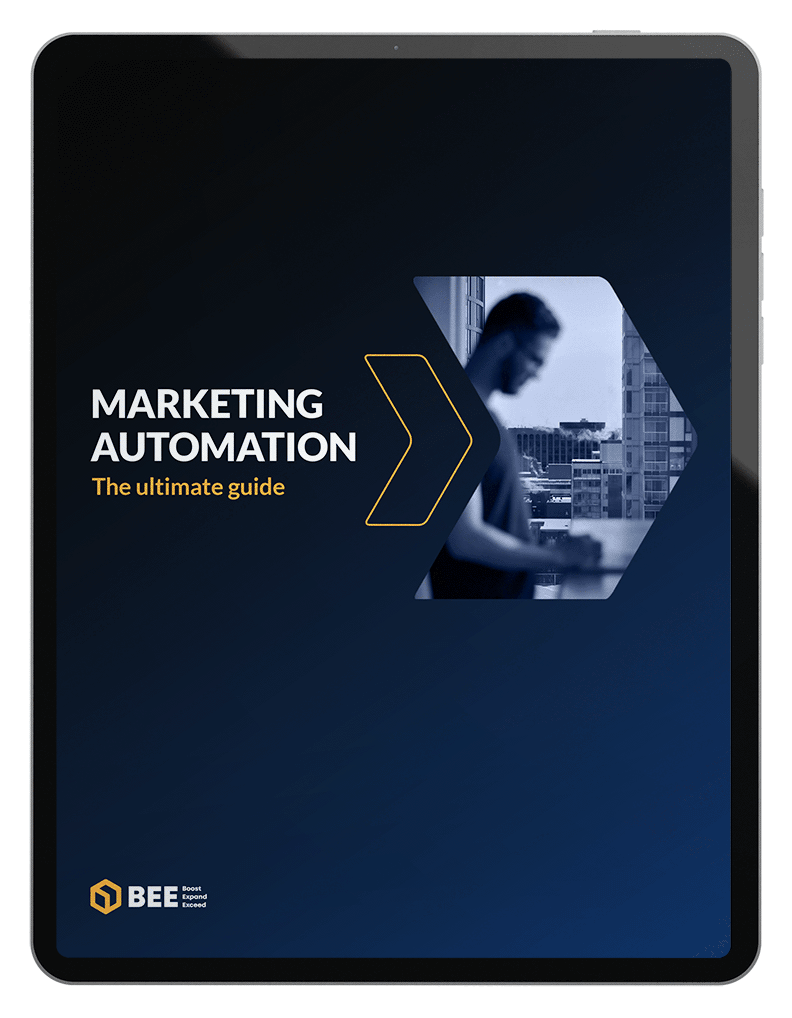
eBook
16 Workflow-Example - The recipe for success for successful marketing automation
BEE is a digital growth solution partner
Transform to perform
For mid-market and corporates in the DACH Region that want to transform their business in order to grow locally and globally, BEE is the highest-ranked digital growth solution partner that combines strategy, execution, data intelligence and people in a transformance model.
What BEE stands for
BOOST performance
EXPAND growth
EXCEED expectations

